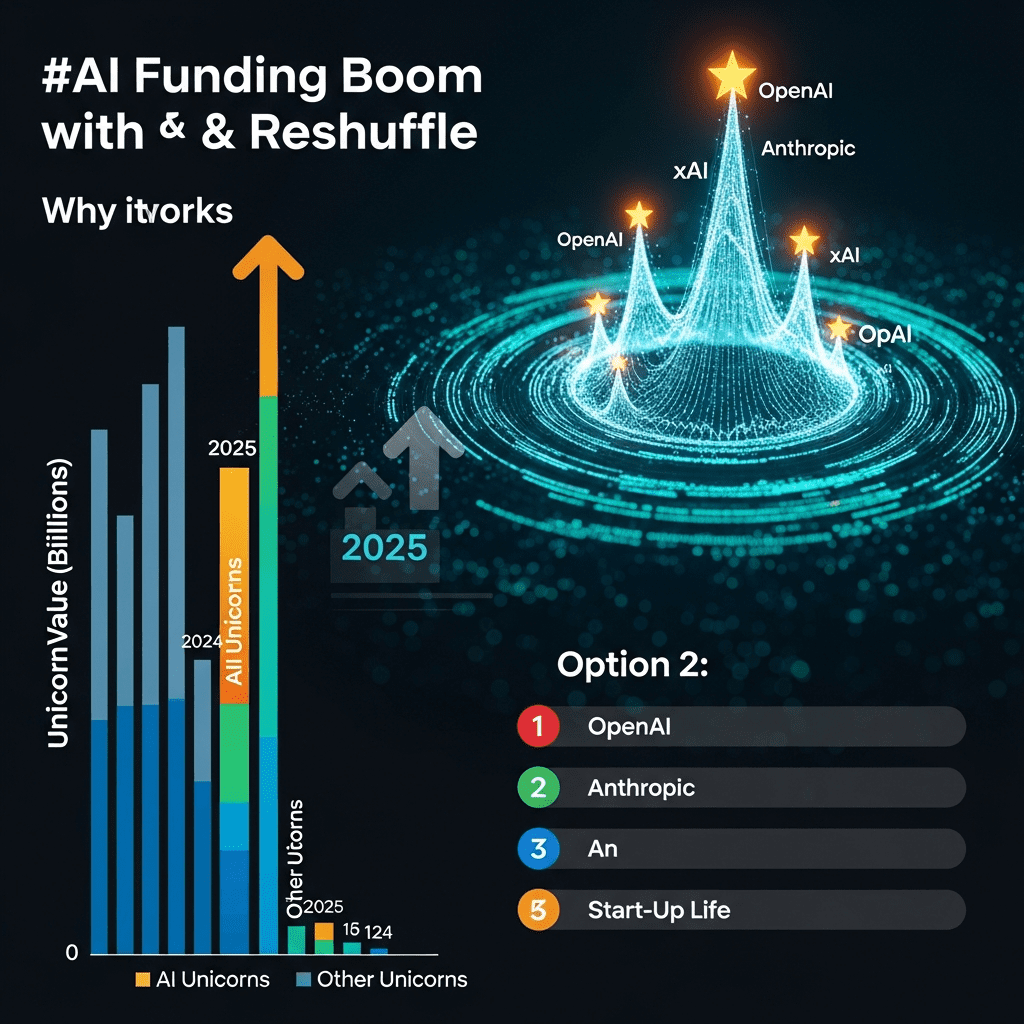Venture-backed AI startups like Anthropic ($PRIVATE:ANTHROPIC) and xAI ($PRIVATE:XAI) secured over $500 billion in new value this year, thrusting the AI funding boom 2025 into global headlines. Unprecedented capital flows have upended the unicorn leaderboard, but how stable is this explosive growth? Investors and founders are scrambling for answers.
AI Unicorn Surge: $507B Value Added to Top 20 Board in Months
Data from CB Insights and PitchBook reveal that AI startups’ aggregate valuation in the global unicorn top 20 leapt by $507 billion between February and October 2025. Notably, OpenAI ($PRIVATE:OPENAI)’s secondary-market valuation soared to $120 billion as of September 2025, doubling from late 2024 (The Information). Similarly, xAI ($PRIVATE:XAI) clinched $6 billion in its May Series B—pushing its value to $24 billion (Reuters, May 2025). Scale AI ($PRIVATE:SCALEAI) rose to $13.8 billion (Bloomberg, June 2025) after a $1 billion round led by Accel. Seven of the top ten unicorns now focus on foundation models, generative AI, or AI infra, compared to just two in 2023. These swift moves shifted Stripe ($PRIVATE:STRIPE) and Shein ($PRIVATE:SHEIN)—longstanding fintech and e-commerce leaders—down the unicorn board.
Why AI’s Historic Capital Influx Is Redefining the Global Startup Market
This wave signals a structural reset in private markets. According to the July 2025 Crunchbase Global AI Funding Report, AI startups commanded 56% of new unicorn capital in Q2 2025—a record high. By contrast, software and fintech unicorn funding fell 24% year over year. The global unicorn count reached 1,332 in October, but nearly half of all new unicorns originated from AI-related verticals. Venture capital firms like Sequoia and Tiger Global are allocating unprecedented portions of their dry powder—sometimes over 70%—to AI deals, reshaping traditional sector weighting. Early IPO rumblings for OpenAI and scaled exits like Databricks signal growing public market pressure to reprice legacy tech unicorns. For public market analysis, a similar AI narrative is impacting mega-cap equities.
How Investors Can Capitalize on the AI Unicorn Rotation
Venture investors face binary outcomes: late entrants risk chasing inflated marks, while early-stage AI backers see historic paper gains. Secondary market volumes for unicorn shares have tripled year-to-date (Forge Global data), pricing major names at steep premiums. Asset allocators should monitor AI vertical ETFs and indexes that track private unicorn exposure as liquidity events approach. For public market traders, exposure through listed AI infrastructure plays (e.g., Nvidia ($NVDA), Super Micro Computer ($SMCI)) offers a liquid proxy to this trend. Conservative investors may prefer diversified funds mitigating single-company risk. For sector-specific deep dives, visit our technology investment analysis and review the latest financial news for real-time exit developments.
What Analysts Expect from AI-Driven Valuation Swings in 2025
Market strategists at Morgan Stanley and industry analysts observe that AI’s abrupt capital influx parallels the late-1990s internet bubble, though institutional diligence appears more robust. Morgan Stanley’s June 2025 research cautioned on valuation dislocations, flagging that median AI unicorn multiples (18x—22x forward sales) far exceed non-AI tech (8x). Consensus suggests that the durability of these multiples will hinge on revenue delivery and regulatory clarity into 2026.
AI Funding Boom 2025 Signals New Era for Unicorn Investors
The AI funding boom 2025 has not only reshuffled the top 20 unicorns but also spotlights the velocity and volatility of AI capital cycles. Investors should watch for liquidity milestones, public listings, and evolving regulatory stances in Q1–Q2 2026. Those agile enough to navigate valuation swings may find opportunities—but discipline is critical amid historic uncertainty.
Tags: AI startups, unicorn funding, OpenAI, venture capital, AI funding boom 2025
